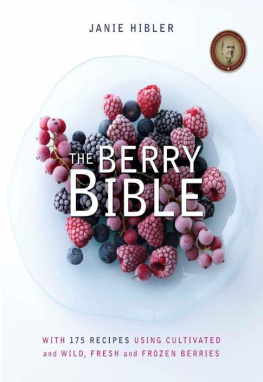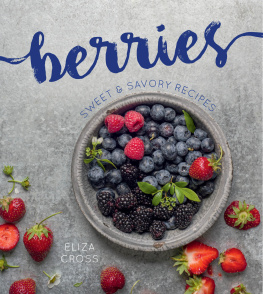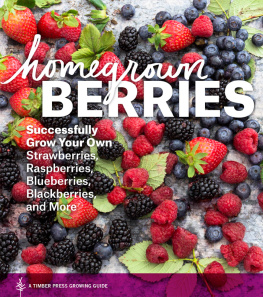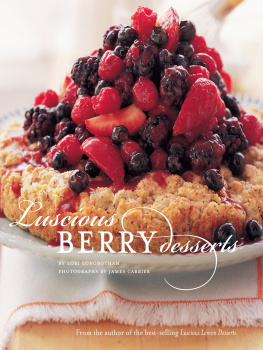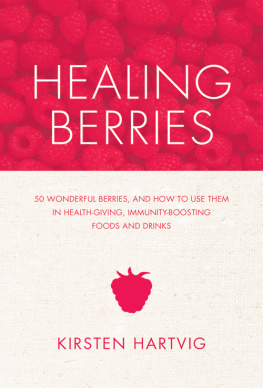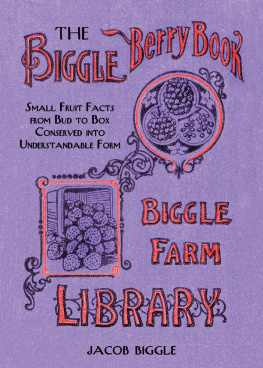No part of this book may be reproduced, or stored in a retrieval system, or transmitted in any form or by any means, electronic, mechanical, photocopying, recording, or otherwise, without express written permission of the publisher.
This book is dedicated to all the people in the berry industry, from the farmers and their harvest crews, to the worlds berry horticulturalists, whose hard work brings such infinite pleasures to our tables.
ACKNOWLEDGMENTS
A special thank you to the following people, without whose help this book could not have been written:
My husband, Gary Hibler, for his invaluable help with proofreading, moral support, and unending patience; my editor, Harriet Bell, whose friendship I value as much as her top-notch editing; and my agent, Judith Weber, for believing in me and this project.
Dr. Chad Finn, for being an inspiration, mentor, and scientific adviser for this book, and to the following for their guidance: Dr. Dan Barney, Dr. Jim Hancock, Dr. Kim Hummer, Dr. Jim Joseph, Steven McKay, Dr. Tom Sjulin, Dr. Gary Stoner, Dr. David Yarborough, Dr. Harlene Hatterman-Valenti, Dr. Jerry Parsons, Dr. Carlos Fear, Vern Nelson, and Dr. Maxine Thompson.
My longtime friend and chief recipe tester, Betty Shenberger, and assistant recipe tester, Shannon Robbins, as well as Susan Franklin, Nancy Smith, Judy Lakin, Karen Pierce, and Kathy Kurtz.
Ed Gowans, who built the berry box and patiently used it to beautifully photograph every berry I brought him.
Chris Benton, copy editor; Ann Cahn, production editor; Karen Lumley, production manager; Roberto de Vicq de Cumptich, jacket art director; and Leah Carlson-Stanisic, interior art directora dream team every author should be lucky enough to have.
The following organizations for their help: the Oregon Raspberry and Blackberry Commission, the Washington Red Raspberry Commission, the British Columbia Blueberry Council, the California Strawberry Commission, the Cape Cod Cranberry Growers Association, the Wild Blueberry Association of North America, the Ontario Berry Growers Association, the International Ribes Association, the Florida Strawberry Growers Association, CanolaInfo, and the Porto Wine Institute.
And to all the others who contributed in one way or another to this book: Carol Adams, Kathy Allcock, Jeff Allen, Claire Archibald, Sonja Atkinson, Beatrice Bentley, Carolyn Bentley, Ed and Aggie Bostrom, Jerry Boucock, Philippe Boulot, Flo Braker, John and Mary Brewer, Julia Child, Chris Christensen, Lois Cochran, Bill and Linda Coonrod, Kerry De Buser, Daphne Dervin, Brooke Dojny, Barbara Durbin, Rick Edwards, Jennifer Flanagan, Jay and Terry Franke, Kassie Franke, Evelyn Franz, Pat Fusco, Darra Goldstein, Jane Hergenhan, Audrey, Emma, Gretchen, and Kelly Hibler, Kristin Hibler, Lynette Hibler, Ross and Betty Hibler, Ross and Jeanne Hibler, Trish Hibler, Betty Lou Hutchens, Joan Ida, Joy Jinks, Rob Kasper, Dan and Betty Kelner, Jim Keyser, Paula Lambert, Anna Tasca Lanza, Dorothy Long, Jude Lutge, Sharon Maasdam, Ed Mashburn, Rick McClure, Ellen McFarland, Cat McKenzie, Janet Mendel, Anne Messelink, Lorinda Moholt, Jeffery Neumeier, Patrick OConnell, Beatrice Ojakangas, Marlene Parrish, Janet and Linda Pendergrass, Pete Peterson, Karen Pierce, Dennis and Rachael Pleasant, Delphine Polon, Molly Schaefer-Priest, Gerald and Jane Rainey, Don Reeser, Marcus Samuelsson, Adam Sappington, Kari Schaefer, Sally Schneider, Eric Schramn, Jan-Marie Schroeder, Jo Seagar, Karen Sehon, Jim Shenberger, Marie Simmons, Jennie and Lee Simpson, Stu Stein, Mary Stewart, Zanne Stewart, Hakan Swahn, Gail Timmons, Tommie van de Kamp, Ed Walker, Doug Walta, Lucia Watson, Patricia Wells, Cathy Whims, Linda Wisner, Catherine Woesthoff, Susan VandeKerk, and Mike Zobel.
The intention of every other piece of prose may be discussed and even mistrusted; but the purpose of a cookery book is one and unmistakable. Its object can conceivably be no other than to increase the happiness of mankind.
INTRODUCTION
I have wanted to write a berry cookbook since 1983, when I completed Dungeness Crabs and Blackberry Cobblers. Although that book was about the culinary history of the Pacific Northwest, I was unable to adequately cover the local berry industry, which produces the greatest diversity of cultivated berries in the world, a fact largely unknown outside the region. The Berry Bible includes a wide range of wild and cultivated berries and fruitsthe product of those 20 years of cogitation. It was a story waiting to be told.
Blueberries, cranberries, and Concord grapes are commonly said to be Americas only three native fruits, but that simply isnt so. Muscadine grapes, blackberries, and black raspberries are 100 percent North American, and lingonberries and red raspberries are both derived from species that are native to the Northern Hemisphere. The first cultivated red raspberries and lingonberries were from European species, but they are the same species that grow in the northern United States and Canada. And strawberries are half North American ( Fragaria virginiana ) and half South American ( Fragaria chiloensis ).
As I was growing up in Arcata, California, 90 miles south of the Oregon border, picking wild berries was one of the highlights of summer. We gathered thimbleberries and salmonberries from the banks of the creek that bordered our property and wild blackberries and coastal huckleberries down by our barn. Going berry picking with the neighborhood kids was a special part of our summer.
As young adults, my husband and I moved to Portland, Oregon, in 1972. We enjoyed hiking in the Cascades and picking many of the same varieties of berries we had grown up with, and we were introduced to the plethora of cultivated berries growing in the fertile Willamette Valley. With our infant daughter in my backpack and our young son equipped with his own bucket, wed spend summer mornings picking berries and the afternoons putting them up. I learned how to make preserves from my German grandmother, and my aunt, who grows blackberries commercially, taught me the secrets of making berry syrups. Stocking my freezer with berries and my pantry with jams, syrups, and fruit leathers was all part of existing on a minimal graduate students budget.
When the children were older, I bribed them and neighborhood kids into helping me pick berries by offering to bake them each a pie of their very own. I could always get a few extra hands that way.
While running a Portland cooking school, one of my greatest pleasures was taking visiting chefs and cooking teachers from other parts of the United States and Europe on drives: I could have them at the nearest berry fields in less than 20 minutes.
It was those rich, fertile soils of the Willamette Valley that attracted pioneers to Oregon in the mid-1800s. With their first plantings they found ideal growing conditions for small fruit crops. The long springs, from the beginning of March to the end of June, gave the fruit time to develop exceptional flavor; the lengthy summer days with little rain and cool nights slowed down the crops growth and made the fruit sweet, while the coastal breezes kept the fruit from rotting.
Numerous members of Oregons berry industry are second- and third-generation families, like the Kerrs, who produce fruit juice concentrates for the wholesale trade and are directly related to the old Portland Kerr family, manufactures of the Kerr canning jar. The infrastructure for Oregons berry industry is built on the foundation laid by previous generations of plant breeders, berry farmers, and processors.

